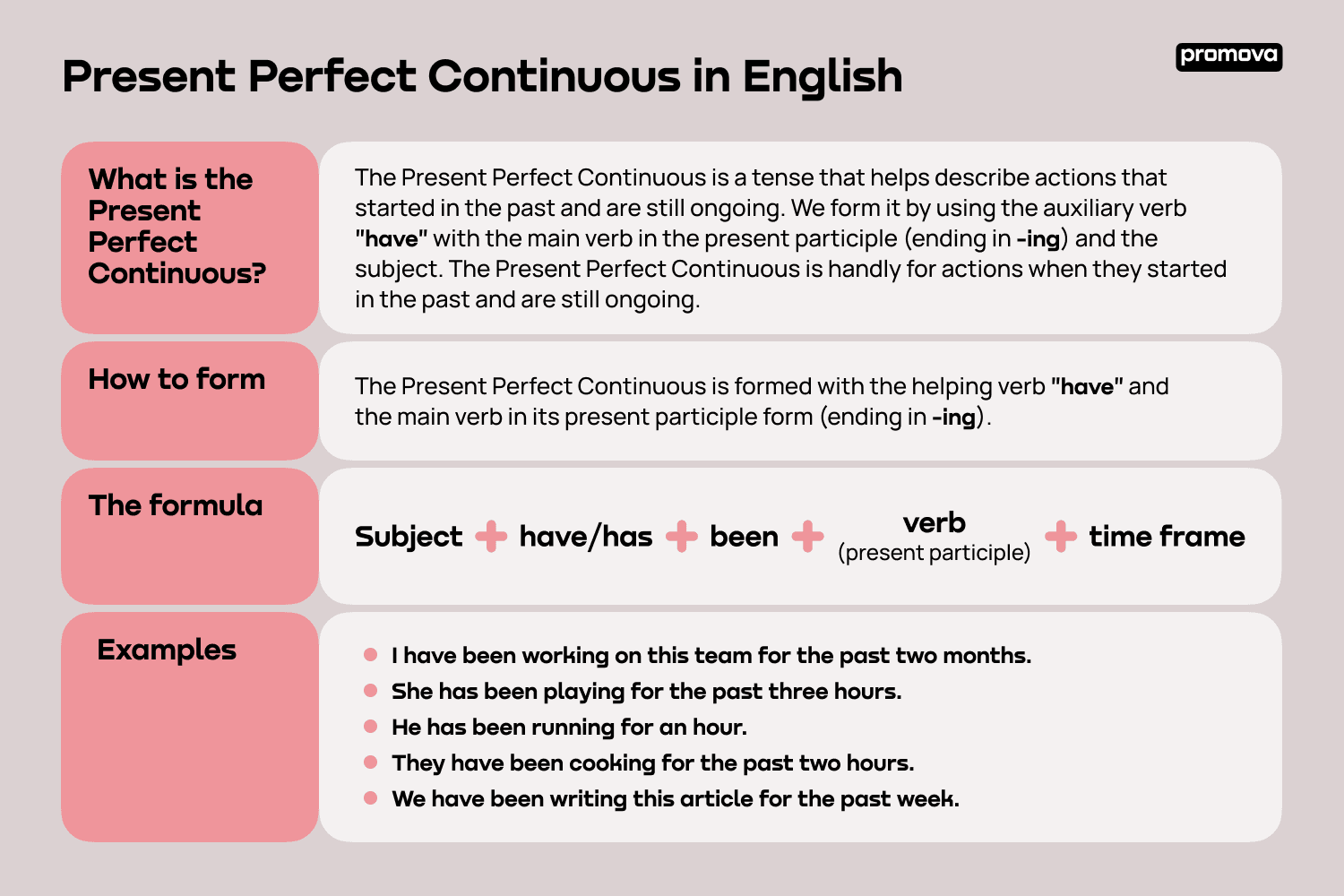Present Perfect Continuous in English
Contents
In this reference, we will be looking at the Present Perfect Continuous in English and discuss how to use it, examples, and common mistakes to avoid. We will also look at the difference between Present Perfect and Present Perfect Continuous and the many ways of using it in your speech. Let's start learning!
What is the Present Perfect Continuous?
The Present Perfect Continuous is a tense that helps describe actions that started in the past and are still ongoing. We form it by using the auxiliary verb "have" with the main verb in the present participle (ending in -ing) and the subject. The Present Perfect Continuous is handly for actions when they started in the past and are still ongoing.
"I have been studying for the past two hours."
In this sentence, the action of studying began two hours ago and is still ongoing.
The Present Perfect Continuous can also help to describe actions that are completed recently.
"I have been studying for the past two hours and I'm done."
In this sentence, the action of studying began two hours ago and is now completed.
How to form the Present Perfect Continuous
The Present Perfect Continuous is formed with the helping verb "have" and the main verb in its present participle form (ending in -ing).
"He has been studying for the past two hours."
In this sentence, the auxiliary verb "have" is used with the main verb "studying" in the present participle form.
The subject of the sentence must always come before the auxiliary verb "have".
"She has been studying for the past two hours."
In this sentence, the subject "she" comes before the auxiliary verb "have".
The formula
Subject + have/has + been + verb (present participle) + time frame
1
Examples of the Present Perfect Continuous Tense
Examples of the Present Perfect Continuous Tense:
- I have been working on this team for the past two months.
- She has been playing for the past three hours.
- He has been running for an hour.
- They have been cooking for the past two hours.
- We have been writing this article for the past week.

Difference between the Present Perfect and the Present Perfect Continuous
The difference between the Present Perfect and the Present Perfect Continuous is that the Present Perfect is used to describe actions that have been completed, while the Present Perfect Continuous is used to describe actions that are still ongoing.
- I have finished my homework. (Present Perfect)
- I have been studying for the past two hours. (Present Perfect Continuous)
In the first sentence, the action of finishing homework has been completed. In the second sentence, the action of studying is still ongoing.
Common mistakes
One of the most common mistakes when using the Present Perfect Continuous is the incorrect use of the auxiliary verb "have". Many people make the mistake of using the auxiliary verb "has" when the subject is singular and the auxiliary verb "have" when the subject is plural.
- She has been studying for the past two hours. (Correct)
- They have been studying for the past two hours. (Correct)
- They has been studying for the past two hours. (Incorrect)
So, the auxiliary verb "has" should not be used when the subject is plural.
Avoid incorrect use of the main verb in the present participle. Many learners make the mistake of using the present simple form of the verb instead of the present participle.
- I have been studying for the past two hours. (Correct)
- I have been study for the past two hours. (Incorrect)
In this sentence, the main verb "study" should be in the present participle form (ending in -ing).
Summary
The Present Perfect Continuous has a number of advantages, such as being useful for describing activities that are taking place over a long period of time, actions that were recently completed, and actions that are repeated over a period of time. If you remember the basic formula of "Subject + have/has + been + verb (present participle) + time frame," it should be easy for you to practice and avoid mistakes. Good luck on your learning journey!
Comments